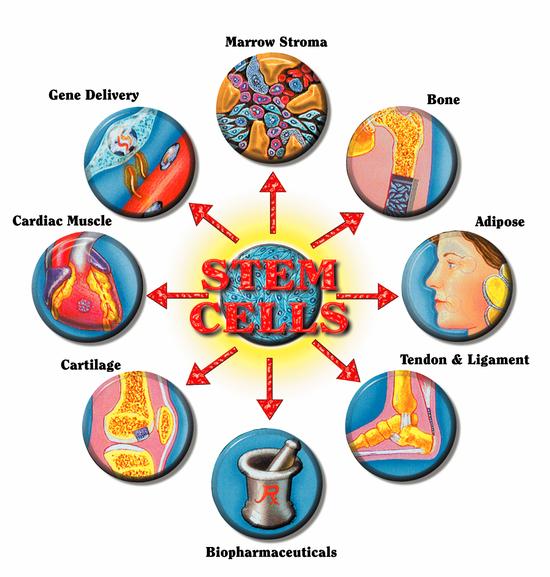Difference between revisions of "Stem cell research"
(Added links, removed redundant heading.) |
Dennisangot (talk | contribs) |
||
| (2 intermediate revisions by 2 users not shown) | |||
| Line 1: | Line 1: | ||
| − | The use of stem cells, specific primal cells that can renew themselves through cell division and that retain the potential to become various cell types, is controversial, especially in religious communities. Because these cells have the potential to multiply and become any type of cell, they are believed to have great medical potential in treating conditions including: cancer, Parkinson's disease, spinal cord injuries, and burns. Stem cells are already used in research, but obtaining funding for continued research is challenging due to pressure from groups who are concerned that embryos might be created and destroyed for research purposes or that research on stem cells could lead to progress in the field of human cloning. | + | [[image: Stem_Cell_Research_Diagram.jpg|200px|right|alt=Stem Cell Research Diagram|Stem Cell Research Diagram]]The use of stem cells, specific primal cells that can renew themselves through cell division and that retain the potential to become various cell types, is controversial, especially in religious communities. Because these cells have the potential to multiply and become any type of cell, they are believed to have great medical potential in treating conditions including: cancer, Parkinson's disease, spinal cord injuries, and burns. Stem cells are already used in research, but obtaining funding for continued research is challenging due to pressure from groups who are concerned that embryos might be created and destroyed for research purposes or that research on stem cells could lead to progress in the field of human cloning. |
Stem cells can be obtained from the embryonic blastocyst, a mass of 50-150 cells formed approximately four to five days after conception, as well as from cord-blood and from adults. Cells from each of these three sources, however, have different levels of use for researchers because of limitations on their abilities to differentiate into any type of cell. Cells from a blastocyst are the most useful to researchers because they most capable of being "influenced" to become any type of cell. | Stem cells can be obtained from the embryonic blastocyst, a mass of 50-150 cells formed approximately four to five days after conception, as well as from cord-blood and from adults. Cells from each of these three sources, however, have different levels of use for researchers because of limitations on their abilities to differentiate into any type of cell. Cells from a blastocyst are the most useful to researchers because they most capable of being "influenced" to become any type of cell. | ||
| Line 12: | Line 12: | ||
LDS Massachusetts Governor [[Mitt Romney]] has also shown support for funding of stem cell research, although he has stated opposition to creating new embryos for that purpose.[http://www.boston.com/news/local/articles/2005/02/11/romney_draws_fire_on_stem_cells/] | LDS Massachusetts Governor [[Mitt Romney]] has also shown support for funding of stem cell research, although he has stated opposition to creating new embryos for that purpose.[http://www.boston.com/news/local/articles/2005/02/11/romney_draws_fire_on_stem_cells/] | ||
| + | |||
| + | [[Category:Controversial Topics]] | ||
| + | |||
| + | [[es:Investigación de la Célula Madre]] | ||
Latest revision as of 01:32, 8 September 2010
The use of stem cells, specific primal cells that can renew themselves through cell division and that retain the potential to become various cell types, is controversial, especially in religious communities. Because these cells have the potential to multiply and become any type of cell, they are believed to have great medical potential in treating conditions including: cancer, Parkinson's disease, spinal cord injuries, and burns. Stem cells are already used in research, but obtaining funding for continued research is challenging due to pressure from groups who are concerned that embryos might be created and destroyed for research purposes or that research on stem cells could lead to progress in the field of human cloning.Stem cells can be obtained from the embryonic blastocyst, a mass of 50-150 cells formed approximately four to five days after conception, as well as from cord-blood and from adults. Cells from each of these three sources, however, have different levels of use for researchers because of limitations on their abilities to differentiate into any type of cell. Cells from a blastocyst are the most useful to researchers because they most capable of being "influenced" to become any type of cell.
Many religious groups have come out strongly against using embryonic stem cells because of their belief that life begins at conception. Mormons, however, have no doctrine defining at what point life begins, so they tend to be inconsistent or neutral in their support of funding stem cell research from embryonic sources.
Mormon Positions on Stem Cell Research
According to the LDS church's official news website, the Church is neutral on stem cell research: "The First Presidency of The Church of Jesus Christ of Latter-day Saints has not taken a position regarding the use of embryonic stem cells for research purposes. The absence of a position should not be interpreted as support for or opposition to any other statement made by Church members, whether they are for or against embryonic stem cell research."[1]
In 2001, a report indicated that all five Mormon senators had come out in favor of federal funding for stem cell research. According to the report: "Hatch and Smith have become the leaders of a movement within the Republican Party to urge President Bush to fund embryonic stem-cell research. All five Mormon senators—the others are Sens. Robert Bennett, R-Utah; Mike Crapo, R-Idaho; and Harry Reid, D-Nev.—have come out for such funding. They have helped move the debate away from right-to-life absolutism without sacrificing pro-life theology. The LDS Church, not the Vatican, is playing the pivotal role in the struggle over stem cells."[2]
LDS Massachusetts Governor Mitt Romney has also shown support for funding of stem cell research, although he has stated opposition to creating new embryos for that purpose.[3]
